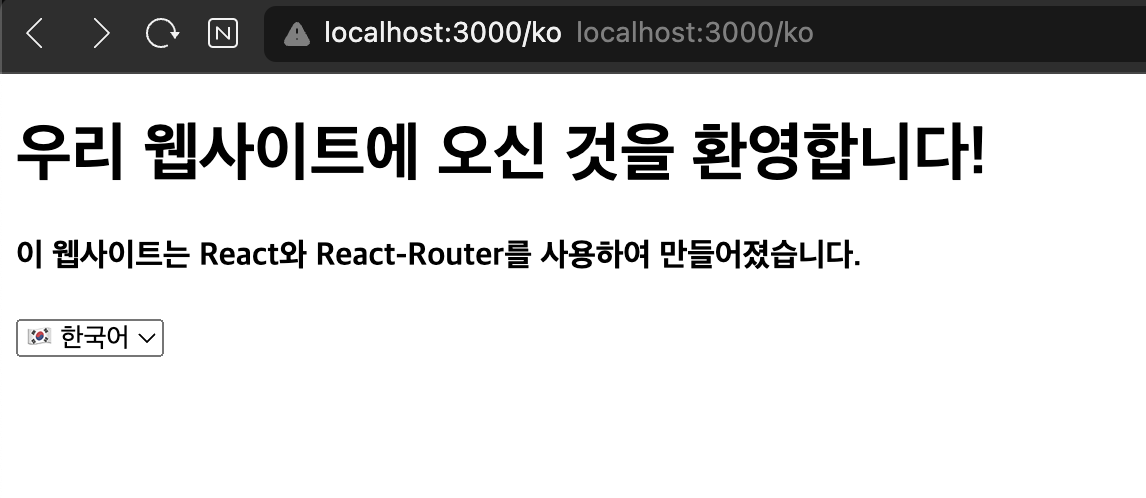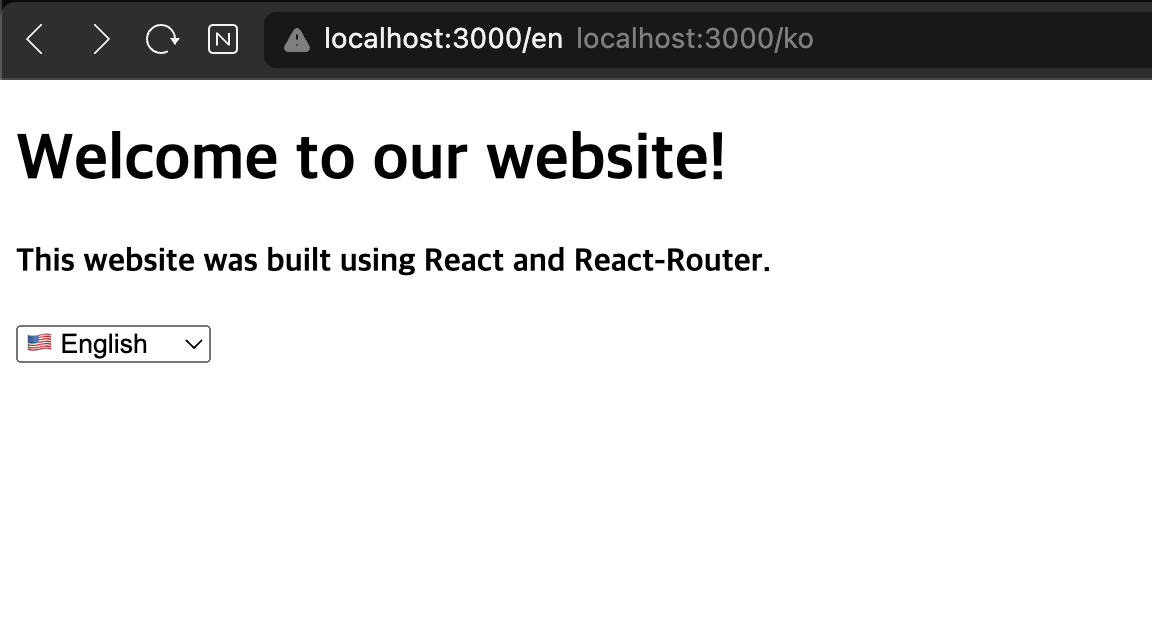Next.js에 i18n 적용하기 - 다국어 처리하기 (next-intl)
8/11/2024
Next.js로 다국어 처리를 도와주는 다국어를 도와주는 여러가지 모듈이 존재합니다.
https://nextjs.org/docs/pages/building-your-application/routing/internationalization
이 글에서는 next-intl을 이용해 다국어 처리를 해보겠습니다.
https://next-intl-docs.vercel.app/
1. 먼저 Next.js를 CLI로 생성합니다.
이 문서에서는 Typescript와 App router를 사용하겠습니다.
npx create-next-app@14 my-nextjs-i18n
2. 다국어 처리에 사용할 next-itnl을 설치합니다.
npm install next-intl --save
3. 먼저 다국어 지원을 처리할 메시지들을 생성합니다.
├── messages
│ ├── en.json
│ ├── jp.json
│ └── ko.json
루트 경로에 다음과 같이 3개의 json파일을 만들고, 내용을 입력해줍니다.
// ko.json
{
"Home": {
"welcome": "우리 웹사이트에 오신 것을 환영합니다!",
"content": "이 웹사이트는 React와 React-Router를 사용하여 만들어졌습니다."
},
"LocaleSwitcher": {
"label": "Change language",
"locale": "{locale, select, en {🇺🇸 영어} ko {🇰🇷 한국어} jp {🇯🇵 일본어} other {Unknown}}"
}
}
// en.json
{
"Home": {
"welcome": "Welcome to our website!",
"content": "This website was built using React and React-Router."
},
"LocaleSwitcher": {
"label": "Change language",
"locale": "{locale, select, en {🇺🇸 English} ko {🇰🇷 Korean} jp {🇯🇵 Japanese} other {Unknown}}"
}
}
// jp.json
{
"Home": {
"welcome": "私たちのウェブサイトへようこそ!",
"content": "このウェブサイトはNext.jsを使用して構築されました。"
},
"LocaleSwitcher": {
"label": "Change language",
"locale": "{locale, select, en {🇺🇸 英語} ko {🇰🇷 韓国語} jp {🇯🇵 日本語} other {Unknown}}"
}
}
4. 이제 next-intl을 사용하기 위한 설정이 필요합니다.
next.config.mjs 파일을 다음과 같이 설정합니다.
/** next.config.mjs */
import createNextIntlPlugin from 'next-intl/plugin';
const withNextIntl = createNextIntlPlugin();
/** @type {import('next').NextConfig} */
const nextConfig = {};
export default withNextIntl(nextConfig);
5. i18n에 관한 설정이 필요합니다.
i18n의 설정과 next-itnl의 미들웨어를 설정합니다.
// /src/config.ts
import {Pathnames, LocalePrefix} from 'next-intl/routing';
// 디폴트로 설정할 로케일
export const defaultLocale = 'en' as const;
// 지원 할 로케일
export const locales = ['en', 'ko', 'jp'] as const;
export type Locale = (typeof locales)[number];
export const pathnames: Pathnames<typeof locales> = {
'/': '/'
};
export const localePrefix: LocalePrefix<typeof locales> = 'always';
export const port = process.env.PORT || 3000;
export const host = process.env.VERCEL_URL
? `https://${process.env.VERCEL_URL}`
: `http://localhost:${port}`;
// /src/i18n.ts
import {notFound} from 'next/navigation';
import {getRequestConfig} from 'next-intl/server';
import {locales} from './config';
export default getRequestConfig(async ({locale}) => {
// Validate that the incoming `locale` parameter is valid
if (!locales.includes(locale as any)) notFound();
return {
messages: (
await (locale === 'en'
? // When using Turbopack, this will enable HMR for `en`
import('../messages/en.json')
: import(`../messages/${locale}.json`))
).default
};
});
// /src/middleware.ts
import createMiddleware from 'next-intl/middleware';
import {localePrefix, defaultLocale, locales, pathnames} from './config';
export default createMiddleware({
defaultLocale,
locales,
localePrefix,
pathnames
});
export const config = {
matcher: [
// Enable a redirect to a matching locale at the root
'/',
// Set a cookie to remember the previous locale for
// all requests that have a locale prefix
'/(de|en|ko|jp)/:path*',
// Enable redirects that add missing locales
// (e.g. `/pathnames` -> `/en/pathnames`)
'/((?!_next|_vercel|.*\\..*).*)'
]
};
// navigation.ts
import {createLocalizedPathnamesNavigation} from 'next-intl/navigation';
import {locales, pathnames, localePrefix} from './config';
export const {Link, getPathname, redirect, usePathname, useRouter} =
createLocalizedPathnamesNavigation({
locales,
pathnames,
localePrefix
});
6. 이제 i18n이 적용된 페이지를 작성합니다.
locale 설정에 따라 http://localhost:3000/ko or http://localhost:3000/en 식으로 경로를 미들웨어에서 바꿔주게 됩니다.
app폴더 아래 [locale] 폴더를 생성해 동적 라우팅을 만들어줍니다.
// src/app/[locale]/layout.tsx
import {NextIntlClientProvider} from 'next-intl';
import {getMessages} from 'next-intl/server';
export default async function LocaleLayout({
children,
params: {locale}
}: {
children: React.ReactNode;
params: {locale: string};
}) {
const messages = await getMessages();
return (
<html lang={locale}>
<body>
<NextIntlClientProvider messages={messages}>
{children}
</NextIntlClientProvider>
</body>
</html>
);
}
messages의 json에 미리 정의해둔 문자를 보여주는 간단한 page.tsx 를 생성해보겠습니다.
'use client';
import {useTranslations} from 'next-intl';
import LocaleSwitch from '@/components/LocaleSwitch';
export default function Home() {
const t = useTranslations('Home');
return (
<div>
<h1>{t('welcome')}</h1>
<h4>{t('content')}</h4>
</div>
);
}
또한 현재 기본 locale을 en으로 설정했기 때문에 루트 도메인으로 접속하는 경우 en locale로 리다이렉트 해주겠습니다.
// src/app/page.tsx
import {redirect} from 'next/navigation';
// This page only renders when the app is built statically (output: 'export')
export default function RootPage() {
redirect('/en');
}
이제 i18n을 위한 설정과 페이지 작업이 마무리 되었습니다. 페이지를 확인해보면 경로에 따라 미리 설정해둔 문구가 보여지는 것을 확인할 수 있습니다.



전체적인 폴더 구조는 이렇게 구성됩니다.
├── messages
│ ├── en.json
│ ├── jp.json
│ └── ko.json
├── next.config.mjs
├── package-lock.json
├── package.json
├── public
├── src
│ ├── app
│ │ ├── [locale]
│ │ │ ├── layout.tsx
│ │ │ └── page.tsx
│ │ ├── layout.tsx
│ │ └── page.tsx
│ ├── components
│ │ ├── LocalSwitchSelect.tsx
│ │ └── LocaleSwitch.tsx
│ ├── config.ts
│ ├── i18n.ts
│ ├── middleware.ts
│ └── navigation.ts
참고자료
